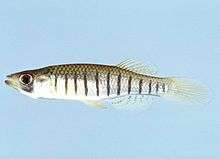Lined topminnow
| Lined topminnow | |
|---|---|
 | |
| Scientific classification | |
| Kingdom: | Animalia |
| Phylum: | Chordata |
| Class: | Actinopterygii |
| Order: | Cyprinodontiformes |
| Family: | Fundulidae |
| Genus: | Fundulus |
| Species: | F. lineolatus |
| Binomial name | |
| Fundulus lineolatus (Agassiz, 1854) | |
The lined topminnow, Fundulus lineolatus, is a small fish in the genus Fundulus which is found in swamps and backwaters from southern Virginia to Lake Okeechobee.
Description
Fundulus is the Latin word for "bottom" and lineolatus is Latin for "having lines".[1]
The fish is silver with black bars and spots, with one of these black bars located underneath the eye, resembling a tear. These bars are only on a minority of the females. The "teardrop" underneath the eye is so prominent that it can be used to tell this species apart from all other topminnows. Some adults are known to have orange and red around their mouths. The maximum size of the topminnow is 1 1/2 inches.[1][2]
It was once believed that Fundulus lineolatus was a subspecies of Fundulus notti, the bayou topminnow. The species resembles the least killifish, which has a dark bar and spots, but has its anus located in its throat region. It also remembles the eastern mudminnow and the mosquitofish.[2]
The sperm and eggs are released into the water in spring and summer, the eggs of the line topminnow being 1.6 mm. While swimming close to the water's surface, the species eat vegetation, crustaceans, and larvae. The northern water snake preys on this fish, as well as another species from the genus, the blackstripe topminnow.[1][2][3]
Habitat
The fishes' habitats are streams, rivers with a small amount of currents or no currents, ponds, and swamps. Swamps include the Okefenokee Swamp. The species is so common and easy to capture that fishermen frequently use them as fishing bait.[1][2]
In 1999, a study by the journal Copeia reported that there may be a correlation between the dams of beavers and how close the fishes' habitat are to these dams.[4]
References
- 1 2 3 4 C. Marcy, Barton (2005). Fishes Of The Middle Savannah River Basin. University of Georgia Press. ISBN 9780820325354. Retrieved July 25, 2013.
- 1 2 3 4 Laerm, Joshua; Freeman, B. J. (2008). Fishes of the Okefenokee Swamp. University of Georgia Press. ISBN 9780820331355. Retrieved July 25, 2013.
- ↑ Whitfield Gibbons, J.; E. Dorcas, Michael (2004). North American Watersnakes: A Natural History. University of Oklahoma Press. ISBN 9780806135991. Retrieved July 25, 2013.
- ↑ W. Snodgrass, Joel; K. Meffe, Gary (1999). "Habitat Use and Temporal Dynamics of Blackwater Stream Fishes in and Adjacent to Beaver Ponds". Copeia. doi:10.2307/1447595. Retrieved July 25, 2013.